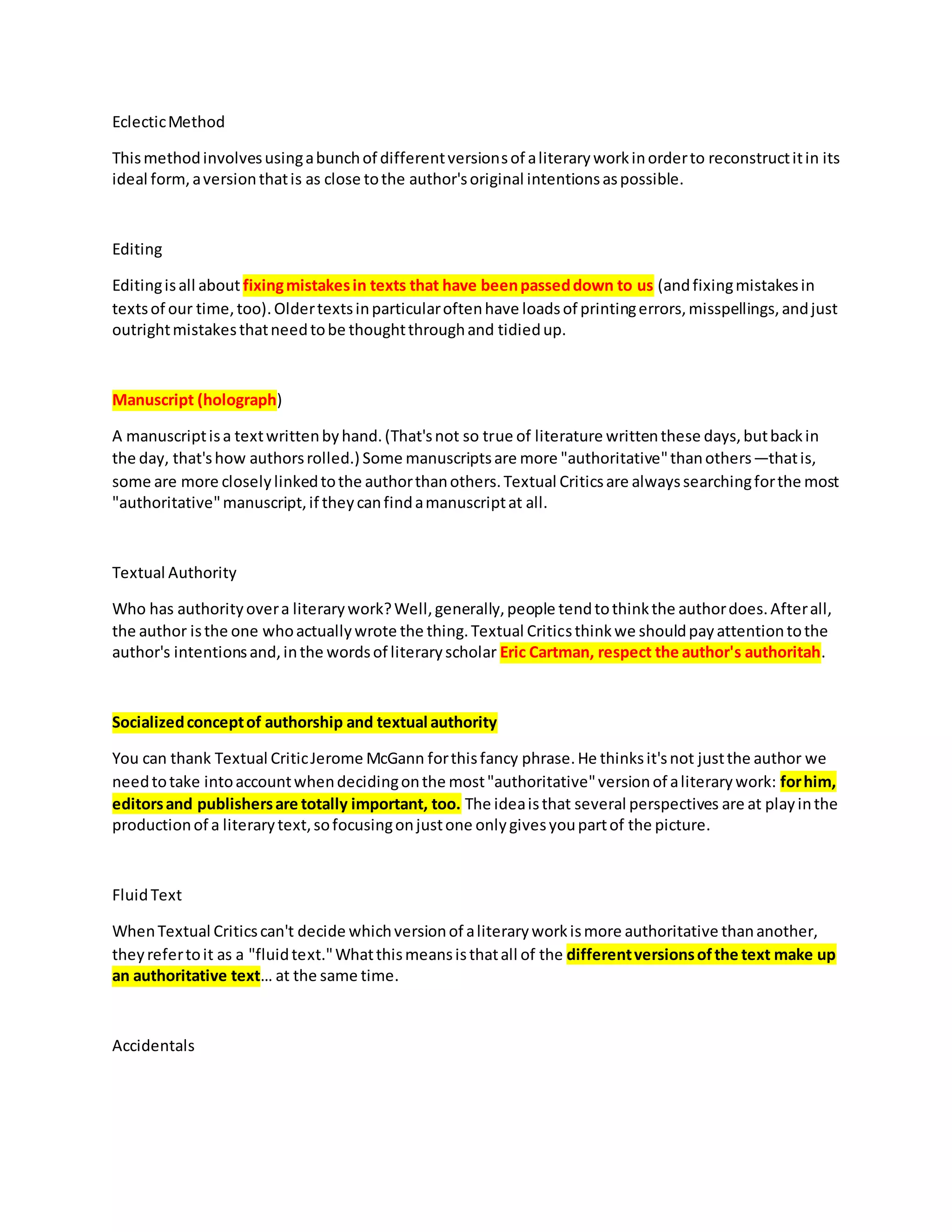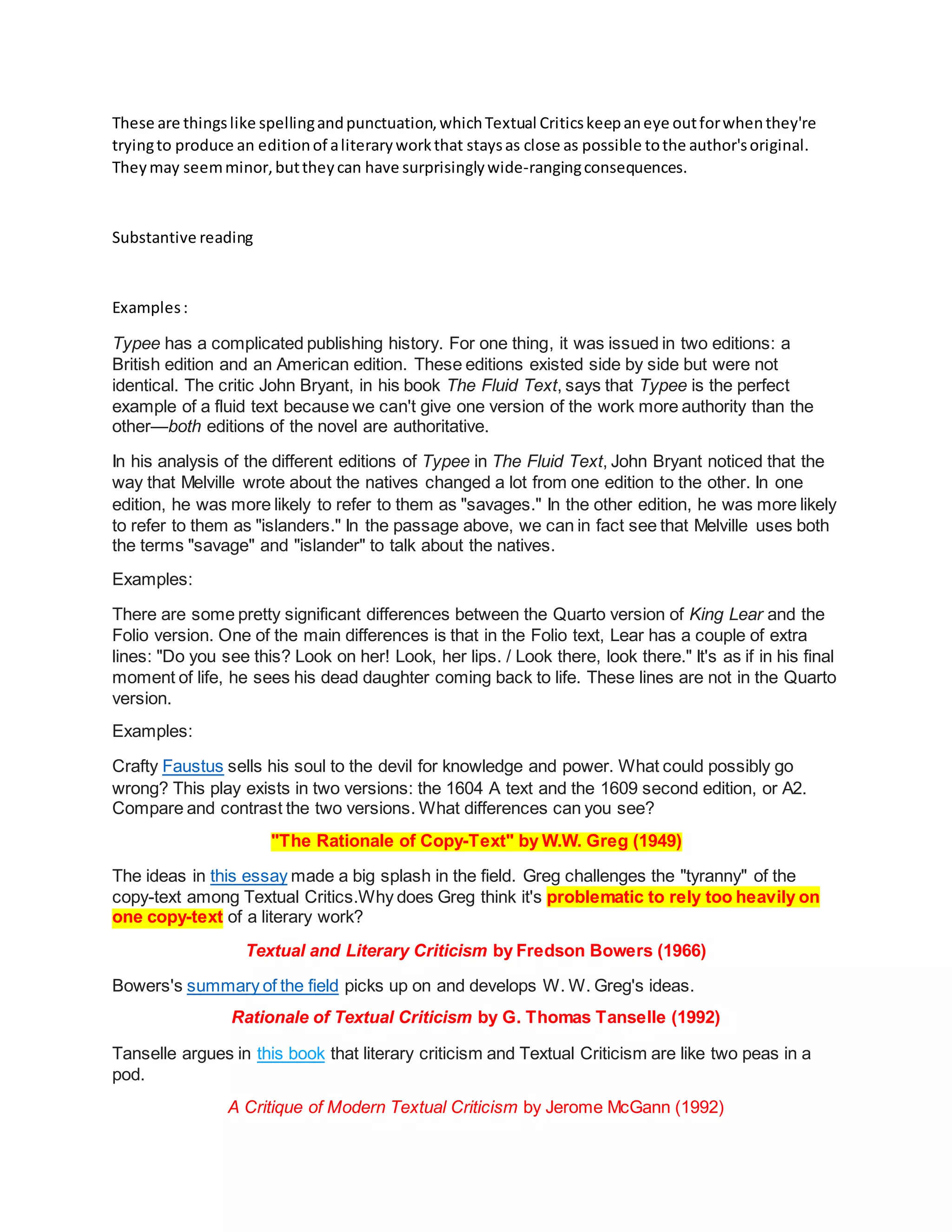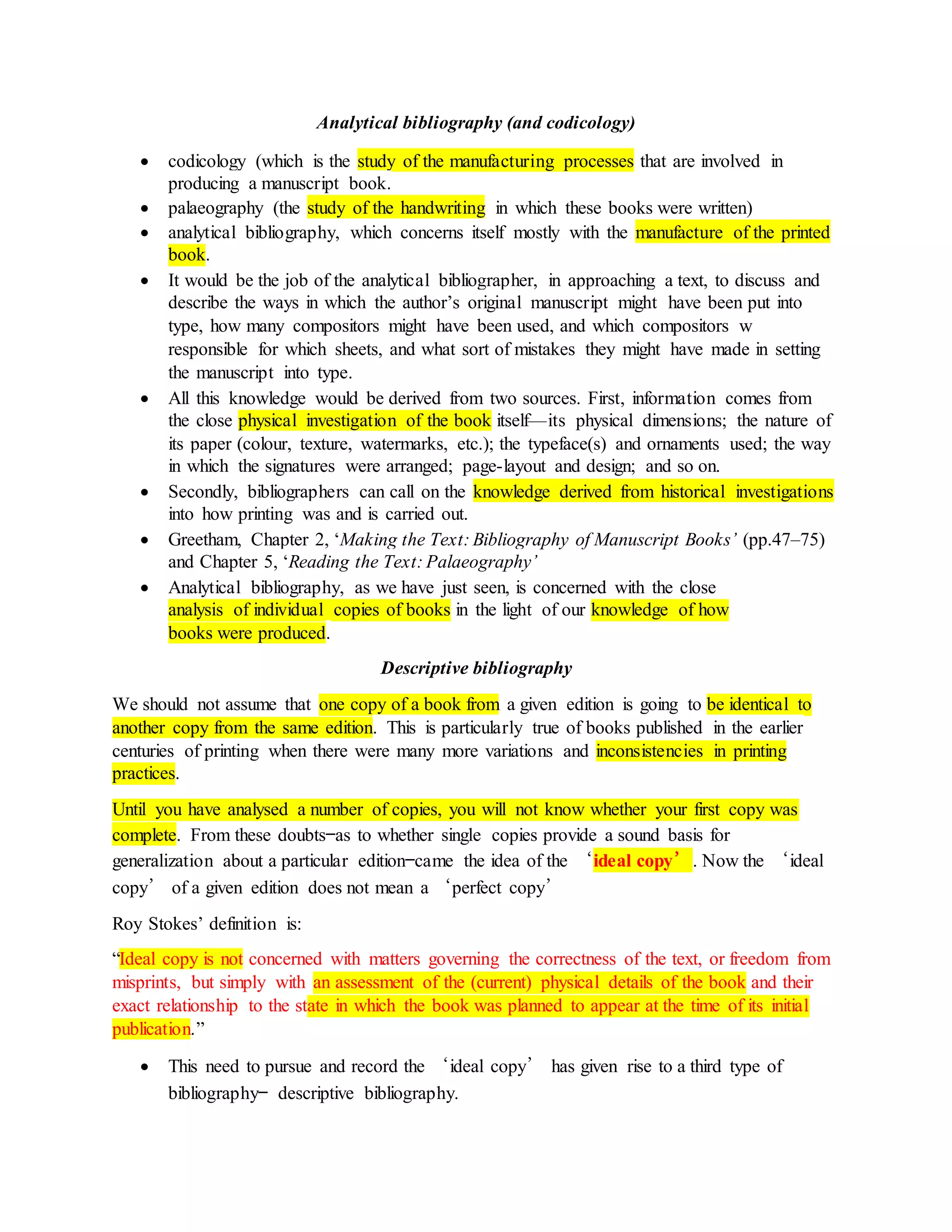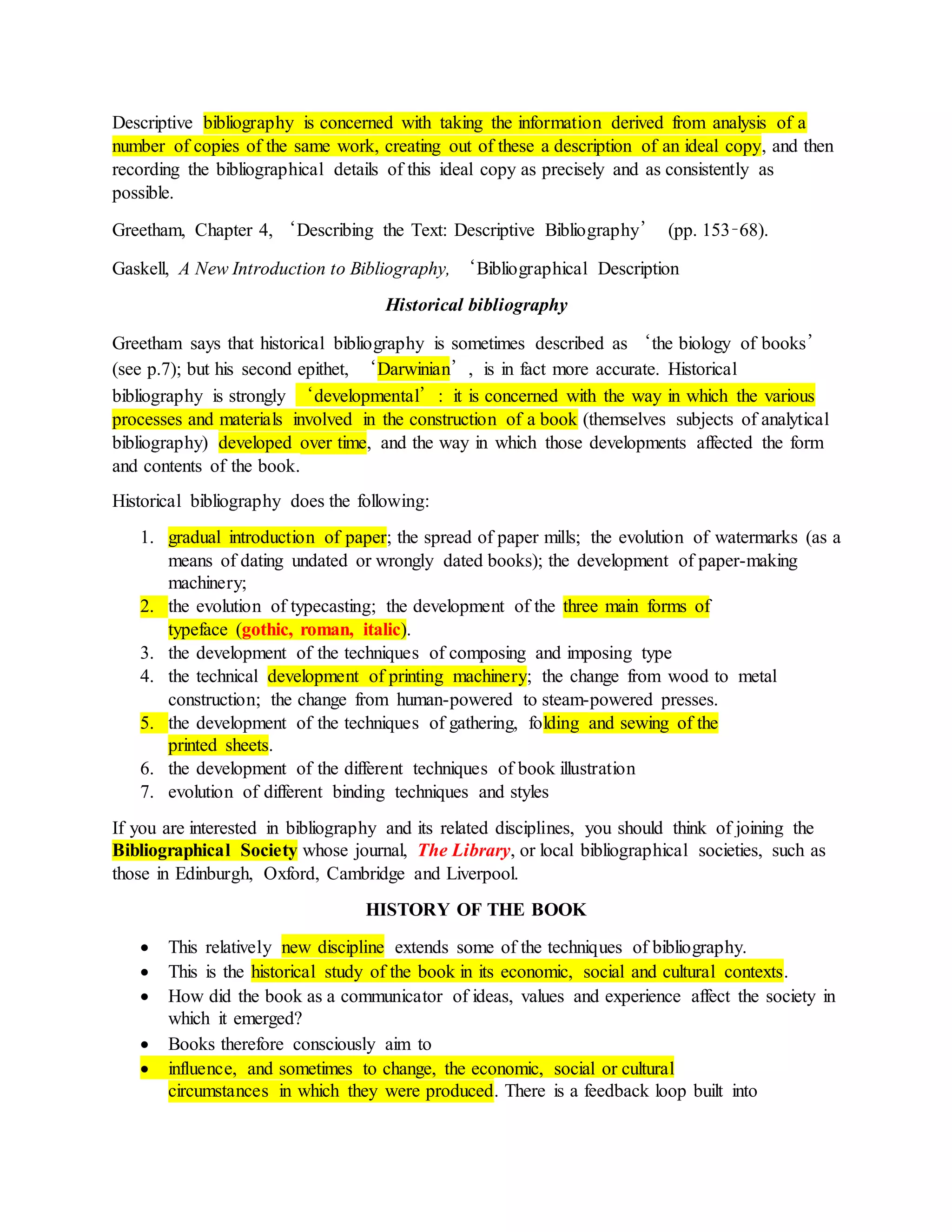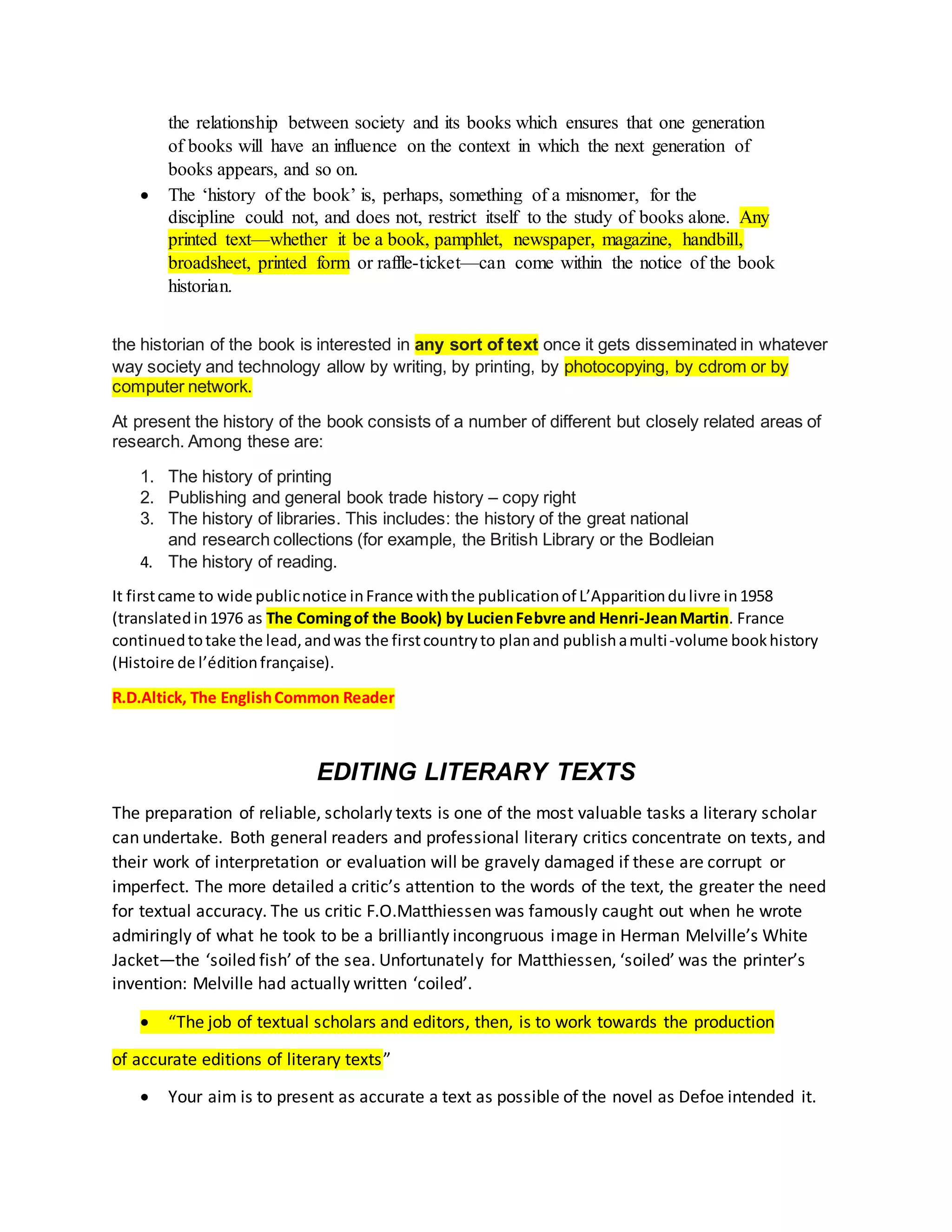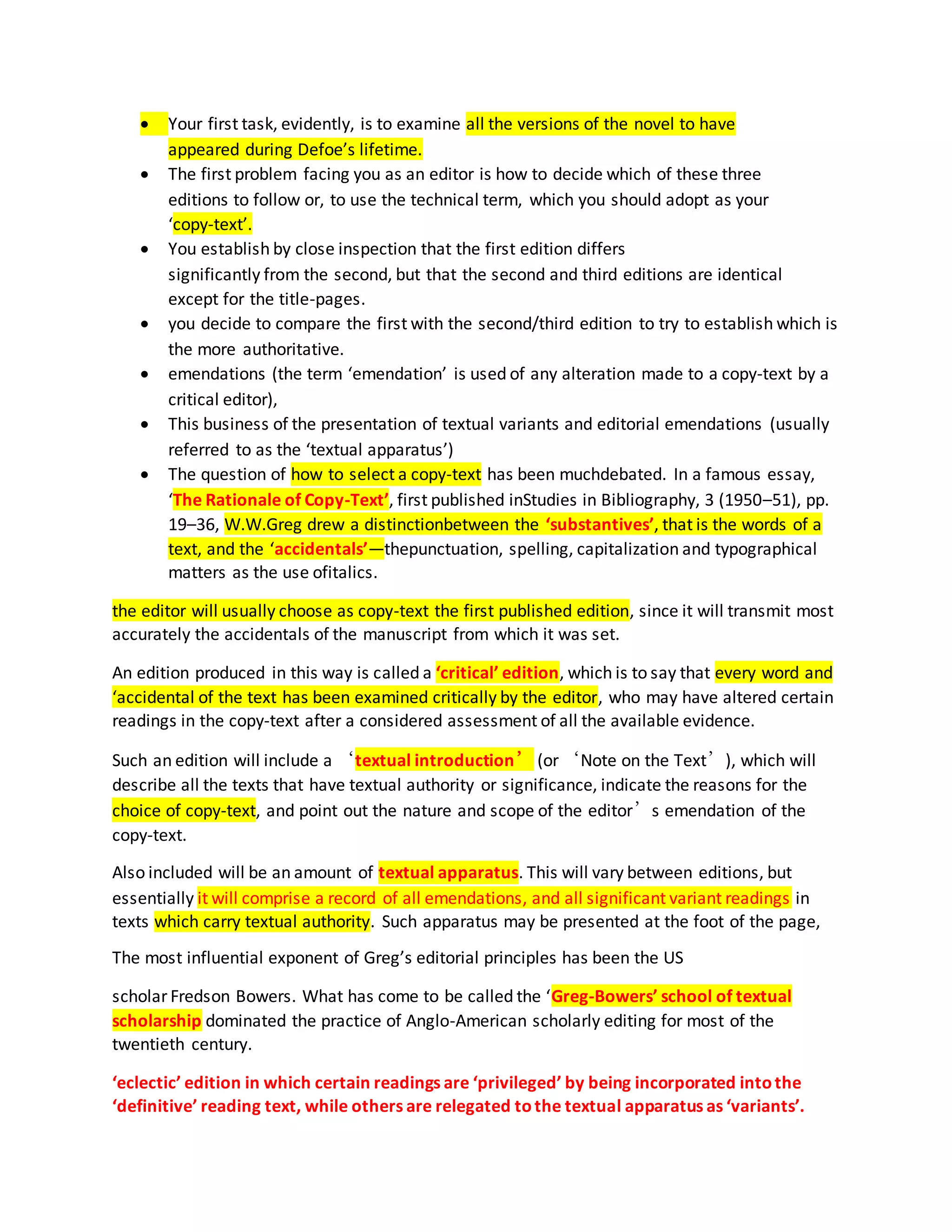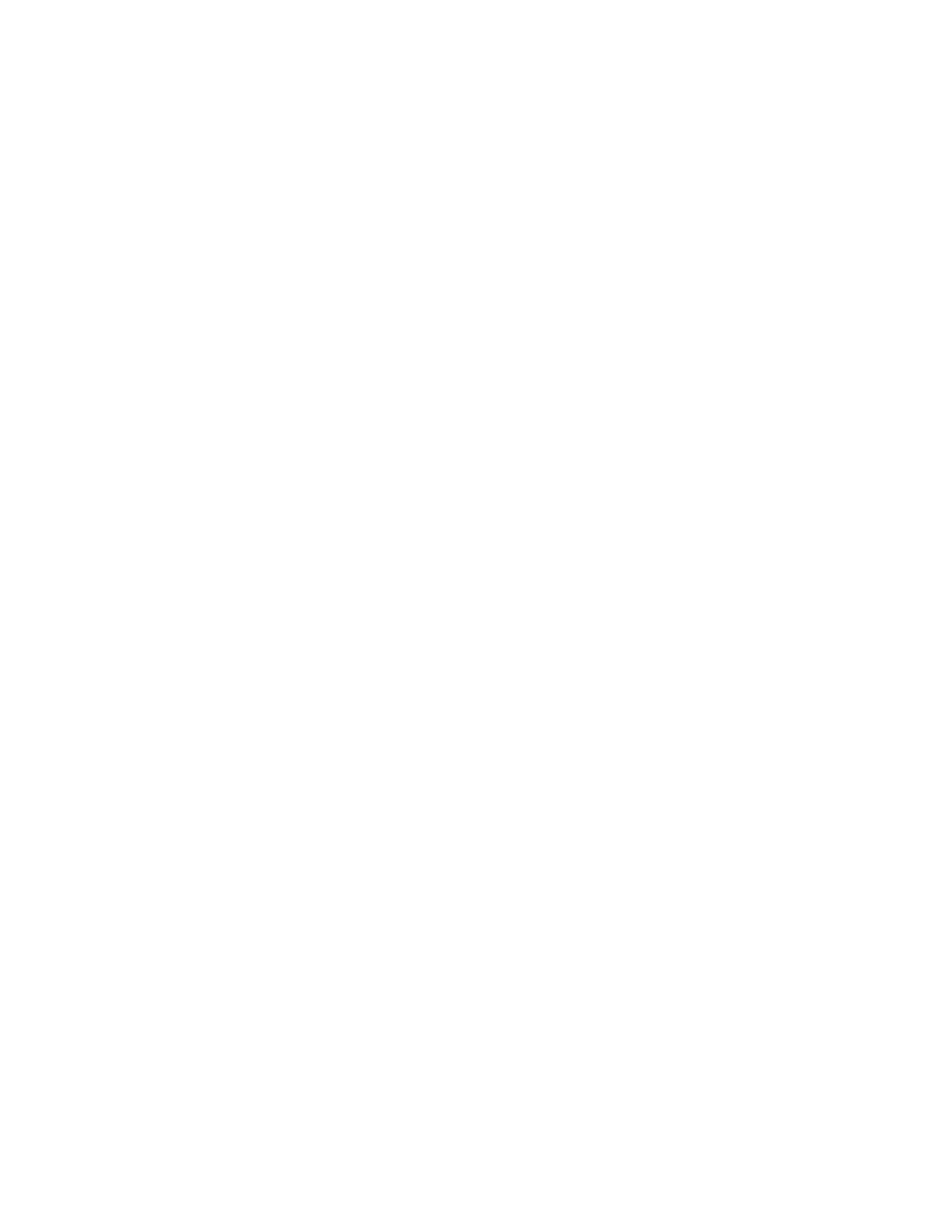This document discusses research methods and materials related to textual criticism and bibliography. It provides background information on important figures in the fields of textual criticism and bibliography such as W.W. Greg, R.B. McKerrow, Fredson Bowers, and G. Thomas Tanselle. It also summarizes some of the key debates in textual criticism, such as debates around the concept of the "copy-text" and whether there can be an "authoritative" text. The document provides a timeline of important works and developments in the history of textual criticism and concludes with two relevant quotes on textual analysis.
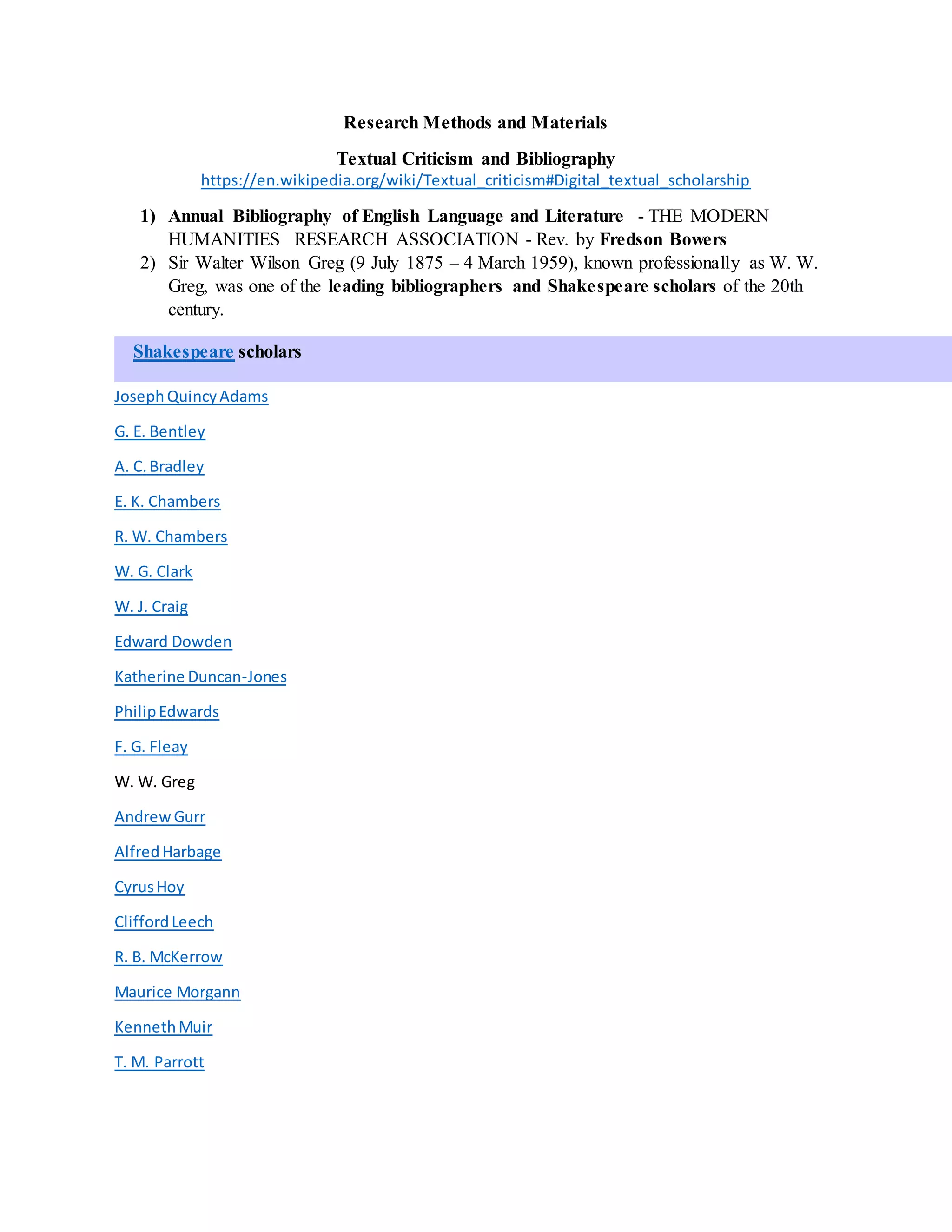

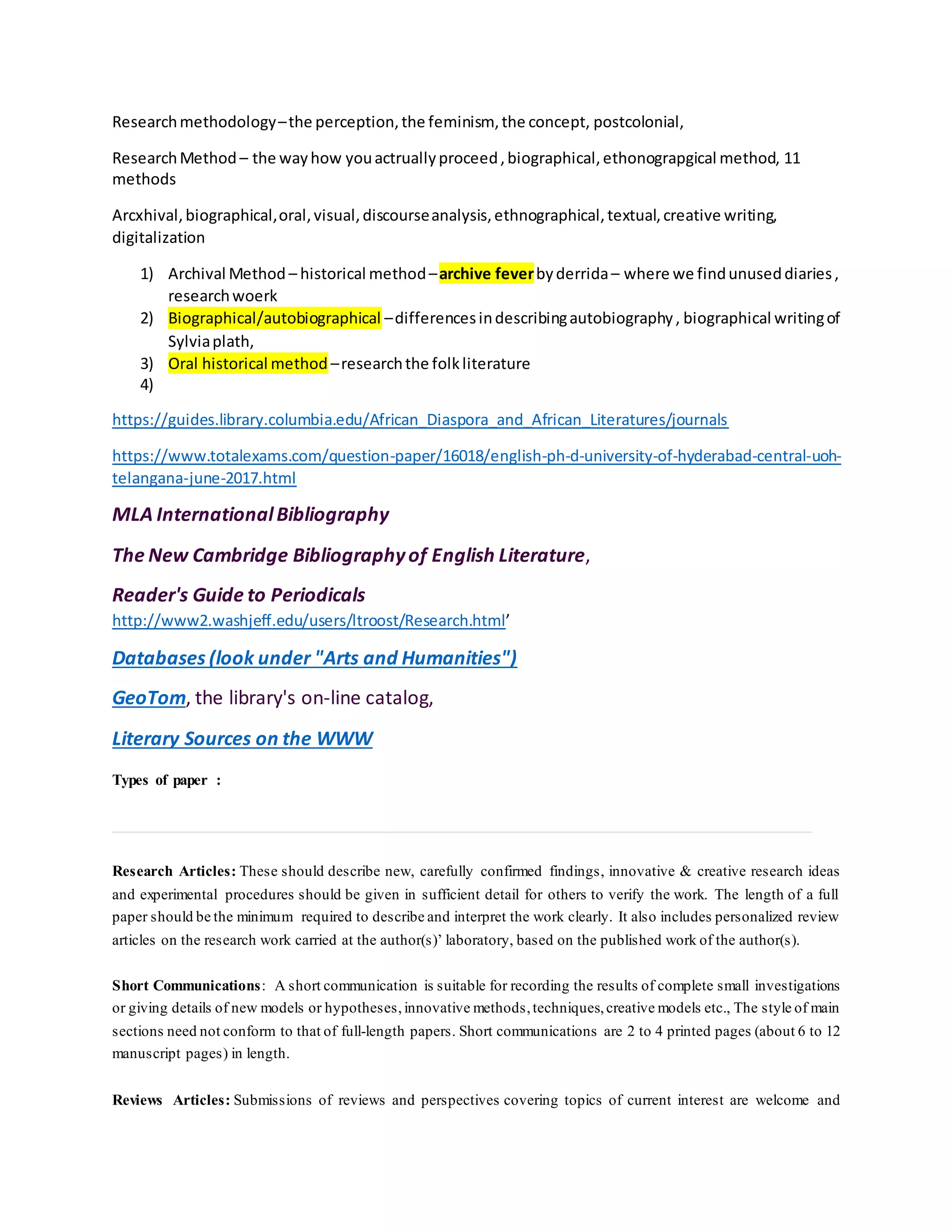

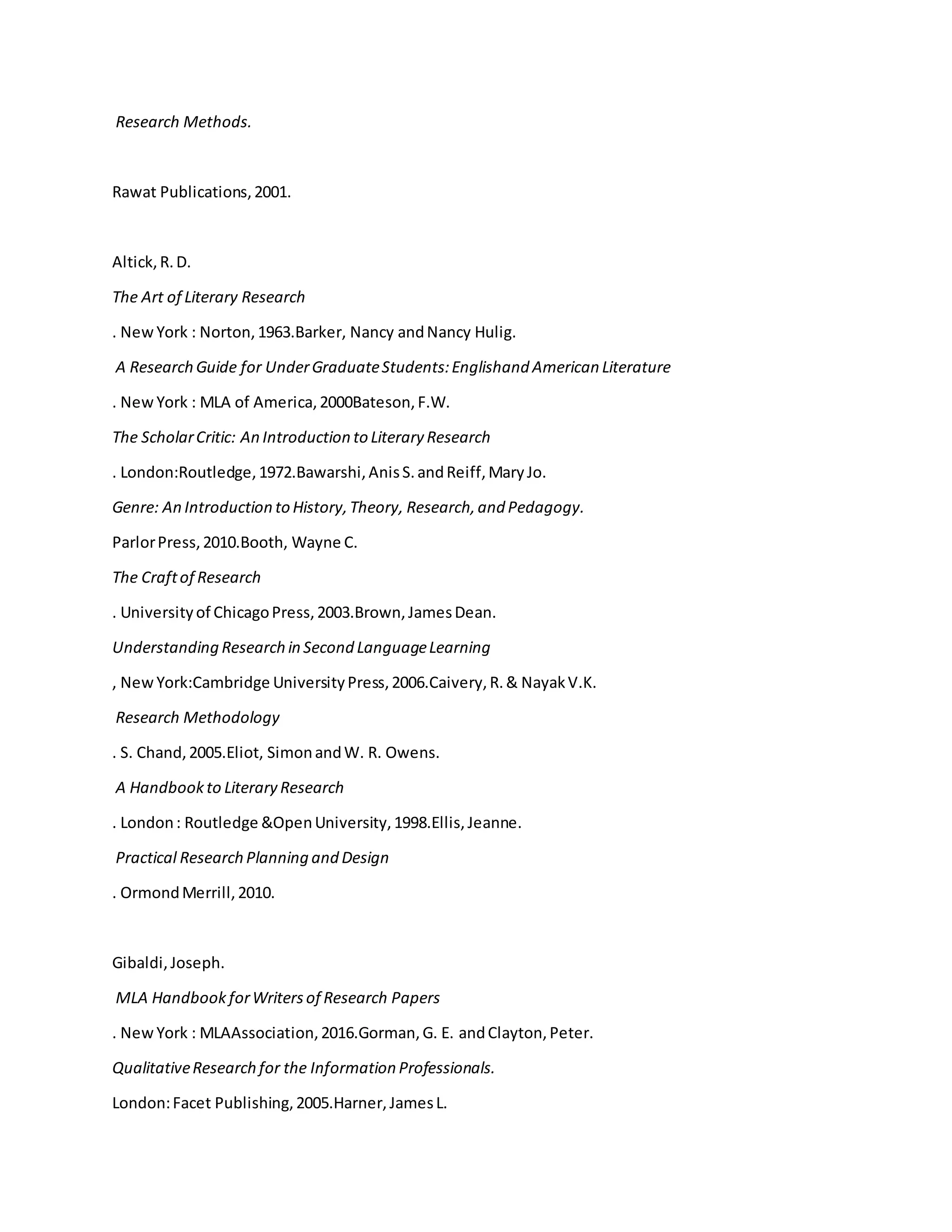
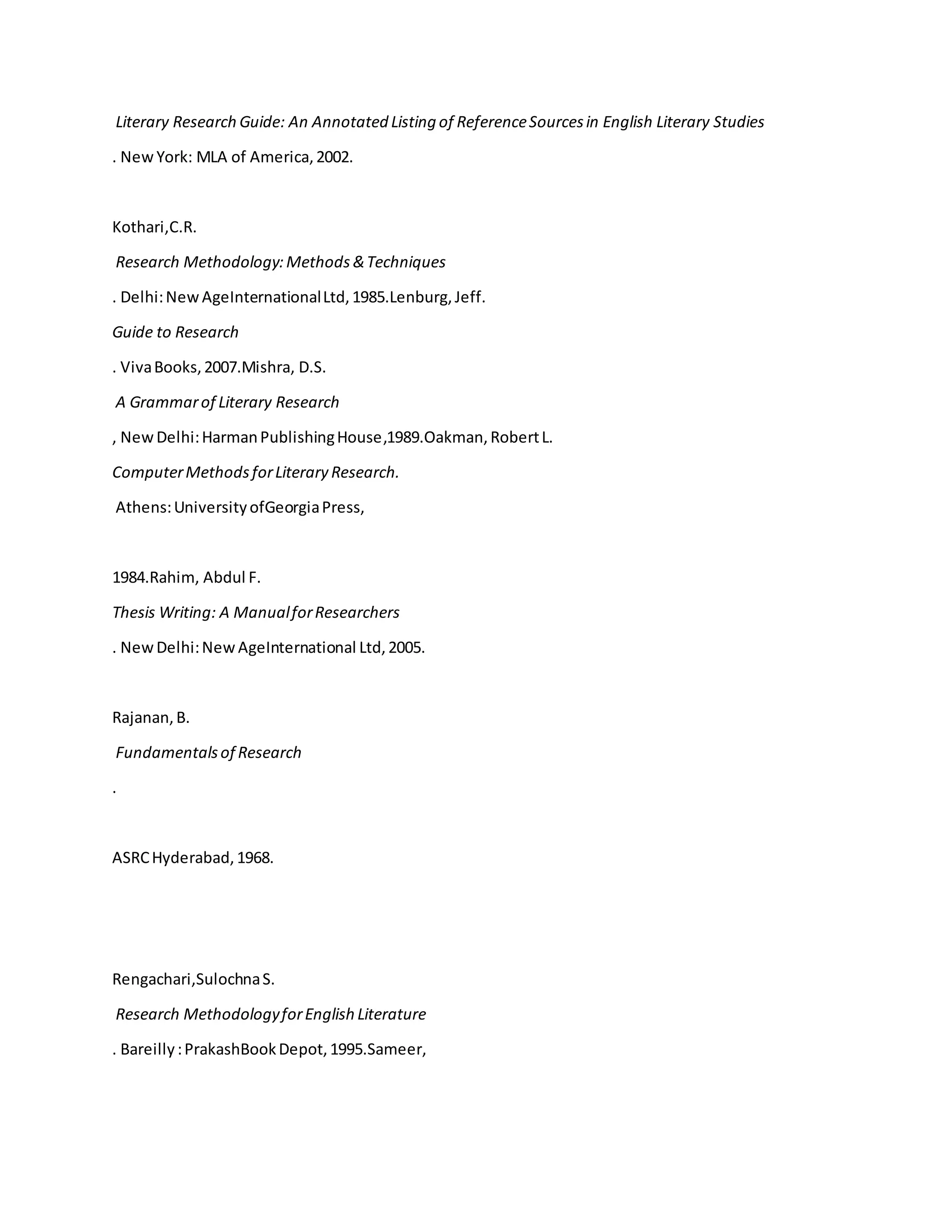
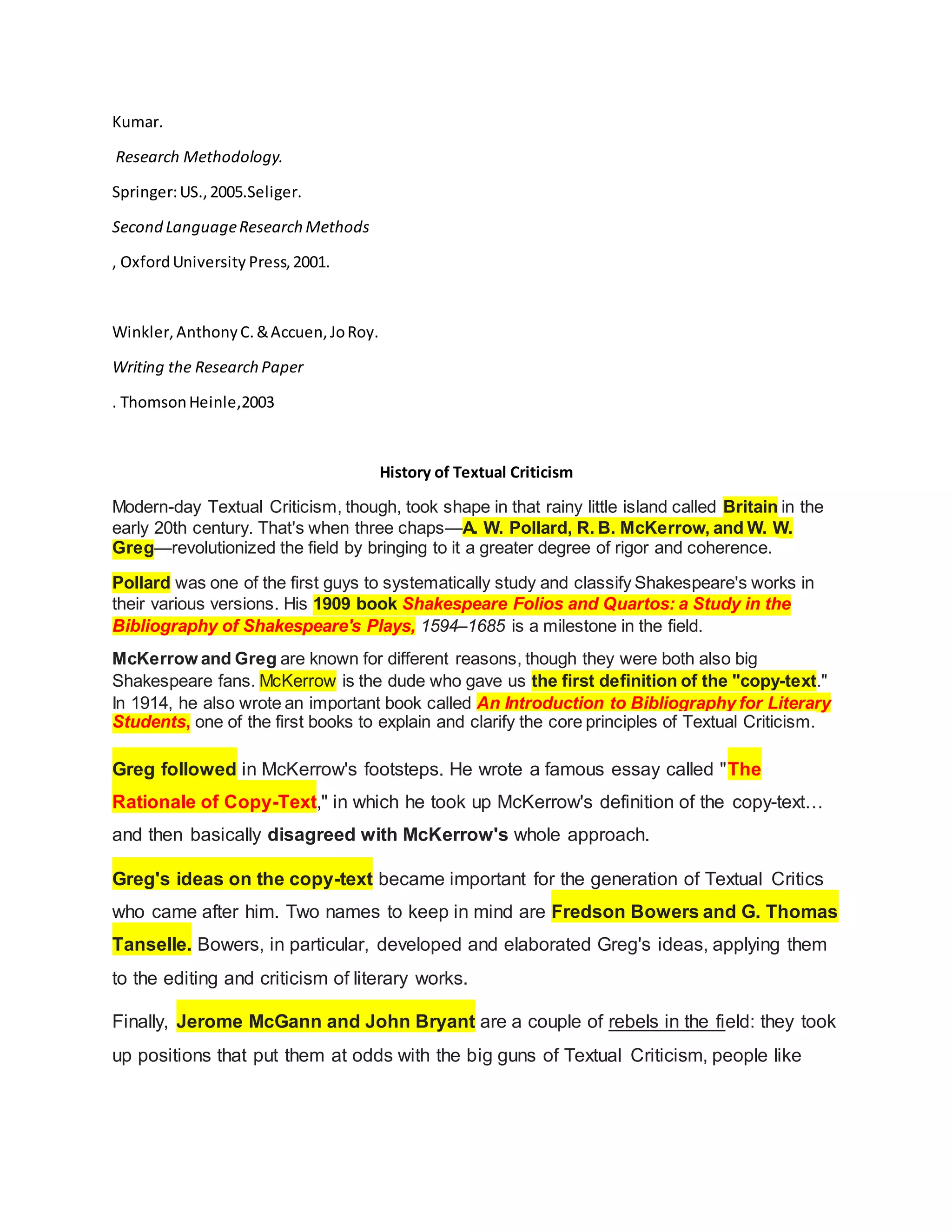
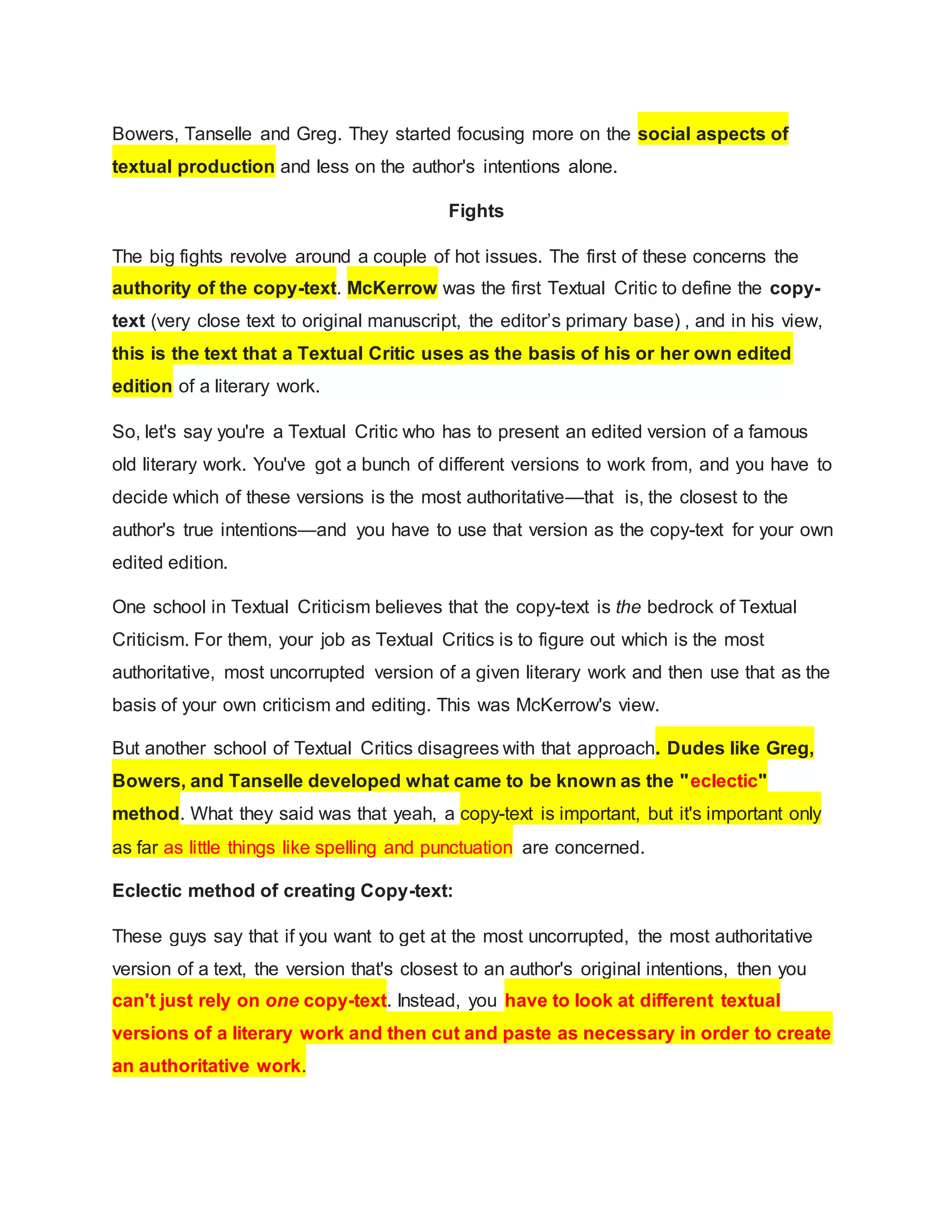
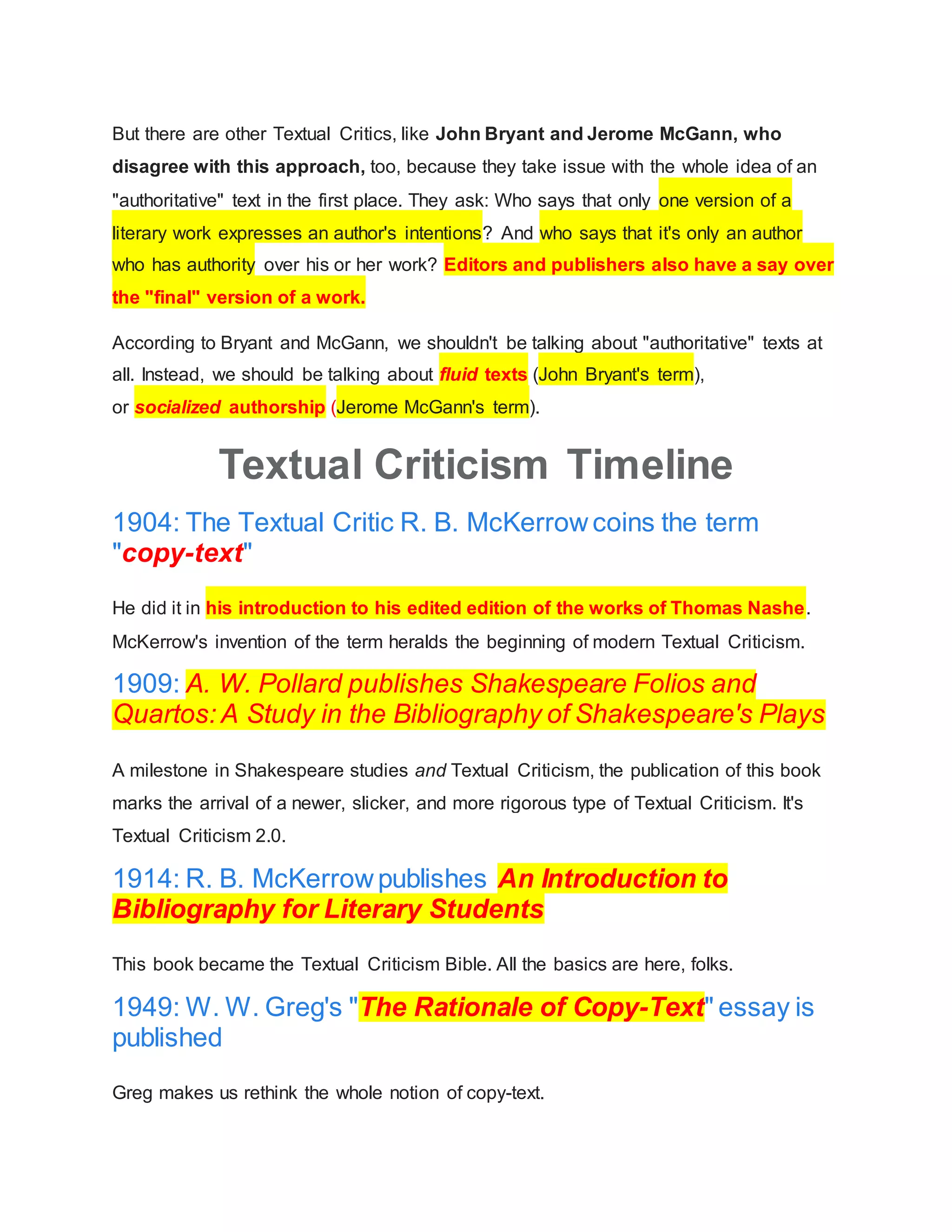
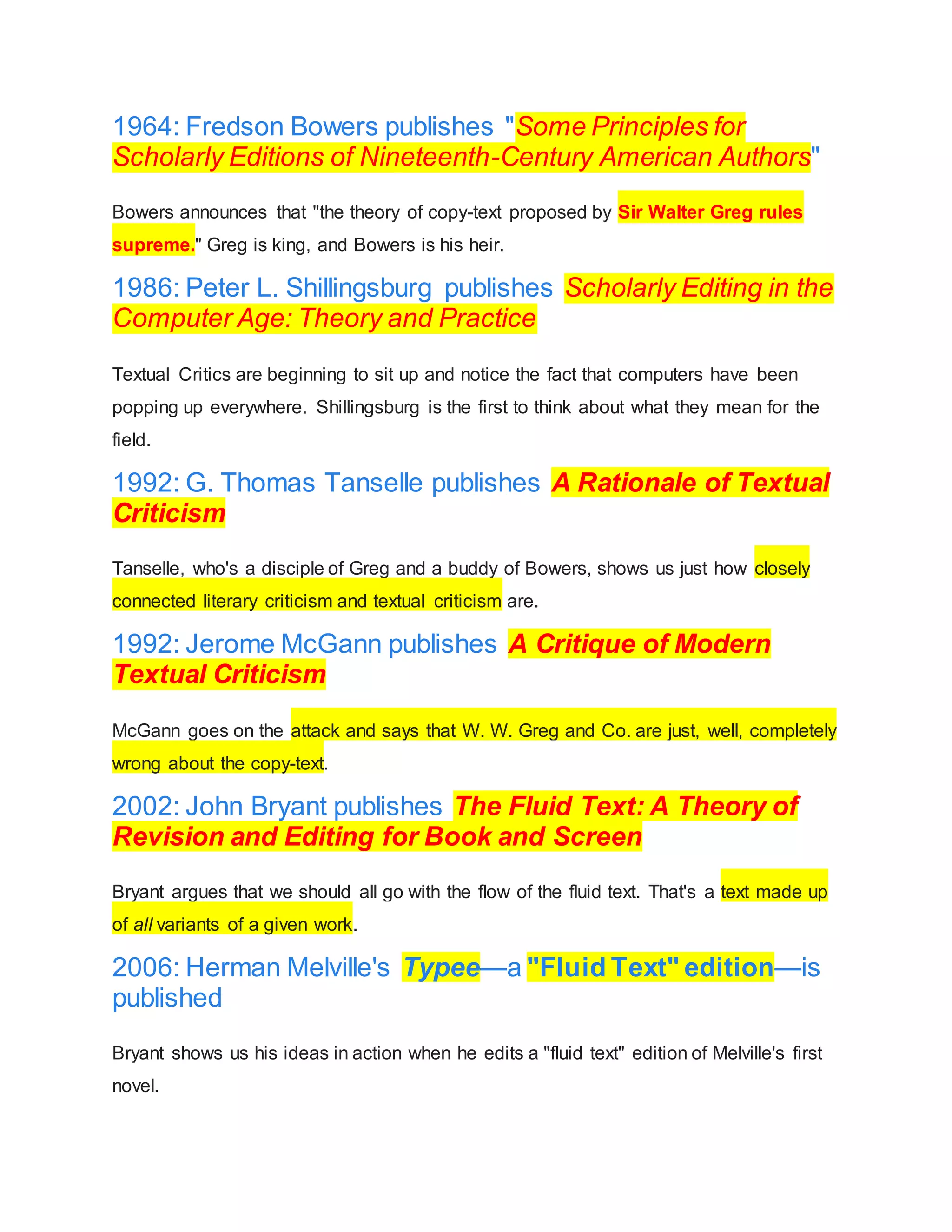
![Quotes:
“The spelling of the copy-text, by which, here and throughout the book, I mean the text
used in each particular case as the basis of mine, [is] followed exactly except as
regards evident misprints.”
- mckerrow
When Textual Critics analyze a text, there are two things in particular they're concerned
with. The first is a "substantive reading" of the text. This kind of reading pays attention
to whether the text being edited accurately reflects the author's true meaning and
expression
The second thing that Textual Critics look out for is "accidentals." These are things like
spelling, punctuation, word-division, and so on.
- W. W. Greg
Many literary classics, including Shakespeare's plays, are available to us only in corrupt
form. Shakespeare's plays, for example, were often transcribed by other people, years
after Shakespeare's death, and we know these people made all kinds of mistakes in
reconstructing his work.
The job of Textual Critics is to recover, as much as possible, the "original" literary work.
Textual Critics interested in Shakespeare's Hamlet, for example, will want to arrive at
the purest, cleanest, most authentic version of that play possible. And that,
according to Bowers, can only be done by using an "eclectic" method.
That means that scholars can't rely on just one version of Hamlet to arrive at an
authoritative edition of the play: they have to look at all the versions of Hamlet
that are available, and they have to reconstruct an authoritative edition of the play out of
all those versions. Textual Critics have to use their own judgment to decide which parts
of each version are authentic and which parts aren't. Then they have to bring it all
together to create an authoritative edition of the play.](https://image.slidesharecdn.com/researchmethodsandmaterials-191209133037/75/Research-methods-and-materials-11-2048.jpg)
![Bowers was influenced by Greg's idea that you can't rely on just one copy-text to
arrive at an authoritative edition of a literary work. The "eclectic method" is all about
looking at different versions of a literary work and using all those versions to re-
construct a super-duper authoritative version of that work.
- Bowers
Who is textual critic?
Textual critics who focus on literary texts (as most people called "textual critics" have done)
concern themselves in one way or another with alterations. Whether they present their work to
the public in the form of editions or of essays, the force that impels their work—indeed, at one
level or another the actual subject of it—is the possibility that received texts are incorrect
(according to one of many conceivable standards) and in need of alteration to set them right.
- TNSELLE
A literaryworkismade up of a bunch of linguisticpatterns.Some writers,like WilliamFaulkner,like to
write insuperlongsentences.Some writers,like ErnestHemingway,liketowrite insupershort
sentences.
The job of Textual Criticsisto identifythese formsandpatterns.Onlyby identifyingpatternscanyou
notice whenthe patternsare broken—asure signthatsomethingsketchyisgoingon.If apatternis
broken,it'sprobable thatsomeone otherthanthe authorhas interferedandcorruptedthe literary
work.A Textual Criticthenhasto try to figure outwhere the textgoeswrongandhow we it can be
corrected.
- Peter L. Shillingsburg
[I]f we are to speakof authoritative texts,it seemsnecessarytolocate the authoritythat controls the
text. Some thinkof the textas belongingtothe reader.Some thinkthe textisautonomous—once
existing,becominginviolablyathinginitself.Some thinkthe textbelongstothe social institutionthat
includes publishersandeditors as well asthe author.Andothersthinkof the text as belongingsolelyto
the author. Of these last,some thinkthe authorretainsauthorityaslongashe livesandrevises;others
thinkauthorityresideswiththe authoronlyaslongashe iscontrolledbythe coherentintentionof
active creativity butislostto himwhenthatcontrol passes.
As diverse asthese positionsmayseem—andtheycanproduce tremendousdifferencesinthe editingof
any giventext—theyall share one thingincommon:eachisa meansbywhichthe critic or editorcan
selectatextof the workof art that excludesall ormostotherversionsof the textfromthe categoryof
authoritative text.
- Peter L. Shillingsburg
“[A] fluid text is any literary work that exists in more than one version. It is "fluid" because
the versions flow from one to another. Truth be told, all works—because of the nature of](https://image.slidesharecdn.com/researchmethodsandmaterials-191209133037/75/Research-methods-and-materials-12-2048.jpg)
![texts and creativity—are fluid texts. Not only is this fluidity the inherent condition of any written
document; it is inherent in the phenomenon of writing itself. That is, writing is fundamentally
an arbitrary hence unstable hence variable approximation of thought. Moreover, we revise
words to make them more closely approximate to our thoughts, which in turn evolve as
we write. And this condition and phenomenon of textual fluidity is not a theoretical
supposition; it is fact.”
Meaning: Why are Textual Critics so obsessed with finding an "authoritative" version of a literary
work? According to Bryant, the idea of an "authoritative text" is misguided, since texts are
always fluid: they're always changing, evolving, growing. That's just the way writing works.
Think of it this way: you have a final paper due for our English class. You're dead set on getting
an A in this class, so you start working on the paper the first week of the term. You write draft
after draft after draft. Sometimes you go back to an old draft and revise that. Sometimes you
just start from scratch.
By the end of the semester, you have a folder on your desktop that has twenty versions of the
same essay. Which one is authoritative? Aren't they all authoritative, in some sense? That's
what Bryant thinks, anyway. The only authoritative text here is the combination of every
draft you wrote: it's a fluid text.
- John Bryant
Sometimestheserelationships[betweenauthorandeditorsandpublishers]operate smoothly,
sometimesthe authorwill struggle againsteverysortof intervention,andbetweenthesetwoextremes
fallseverysortof variation[…] "Final authority" for literaryworks restsneitherwiththe author nor
with hisaffiliatedinstitution;itresidesinthe actual structure of the agreementswhich these two
cooperatingauthoritiesreachinspecificcases.
- Gerome Mc Gann
Big Concepts from Big Minds
Copy-text
Thisis the texton whicha Textual Criticbaseshisorher owneditionof aliterarywork.It'susuallythe
cleanest,awesomest,mostuncorruptedversionof anauthor'swork thatwe can find.Eventhistextwill
probablyhave a lotof problems,butthe pointisthatishas fewerproblemsthanother,messierversions
of the text.
Authoritative
The authoritative versionof atextis the bestversionof the text:ithas the fewestproblemsandmost
closelyreflectsthe author'sintentions.Partof a Textual Critic'sjobistodetermine whichversionof text
isthe authoritative one.Sometimesthe choice isfairlyeasy,butsometimesthere are alotof competing
textsdemandingattention.](https://image.slidesharecdn.com/researchmethodsandmaterials-191209133037/75/Research-methods-and-materials-13-2048.jpg)
